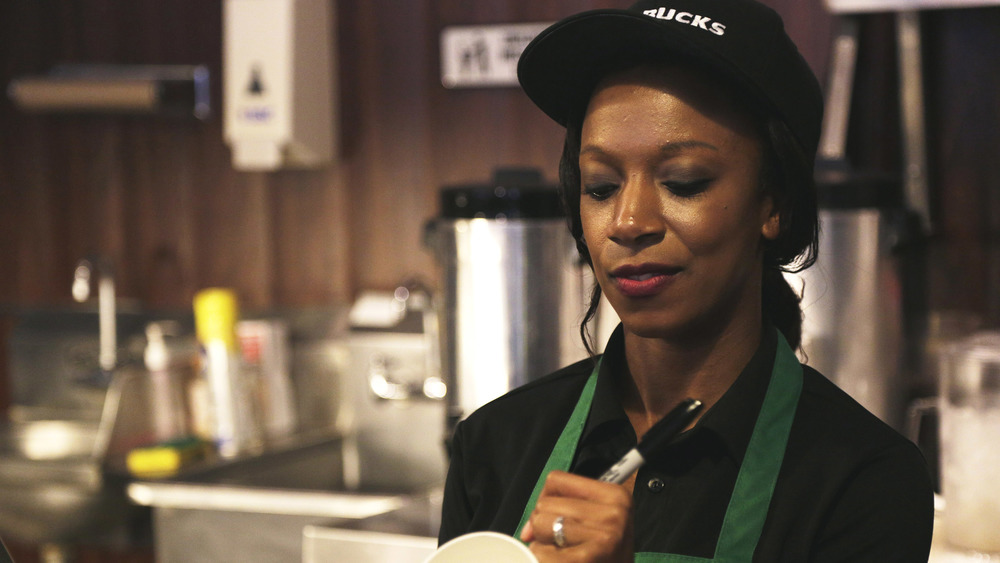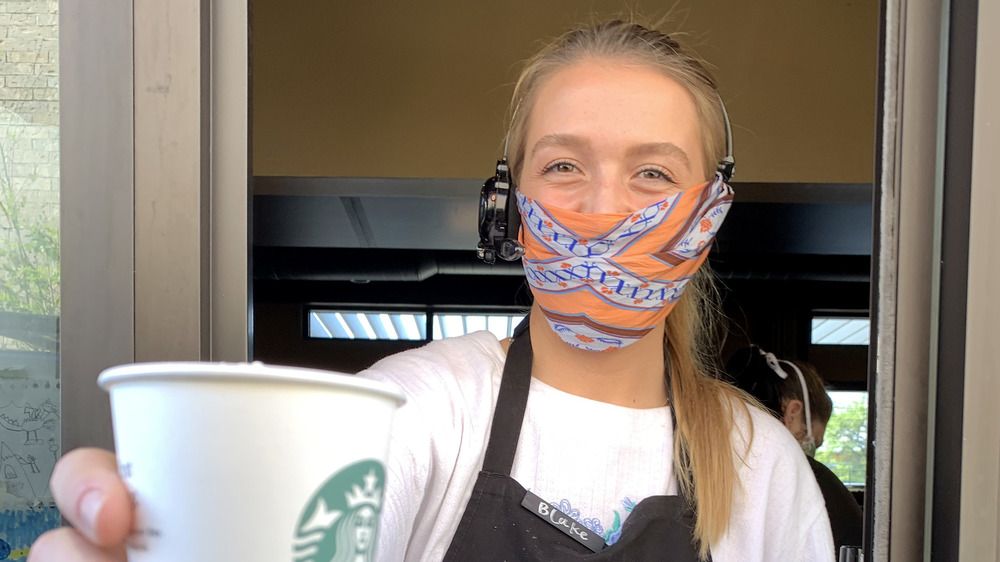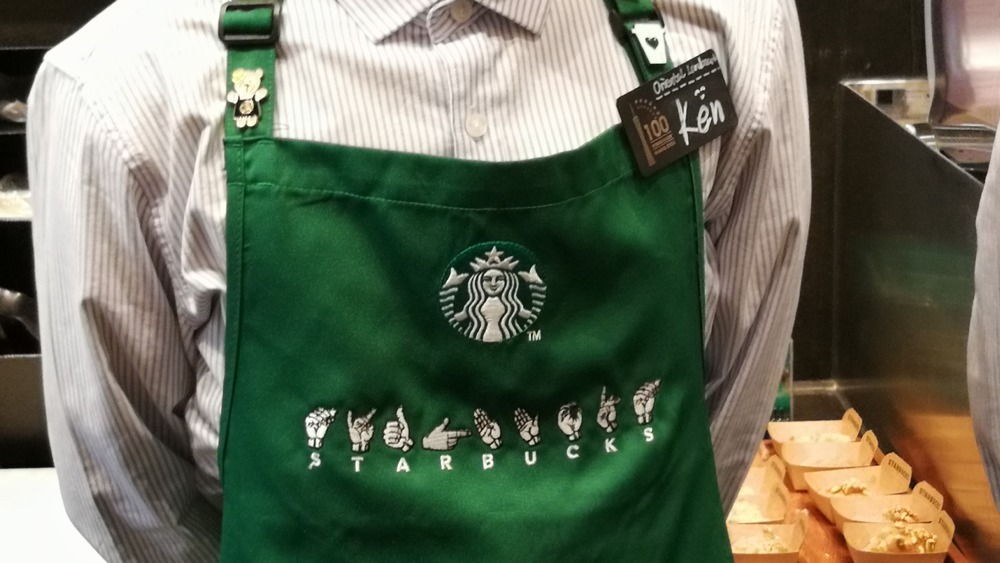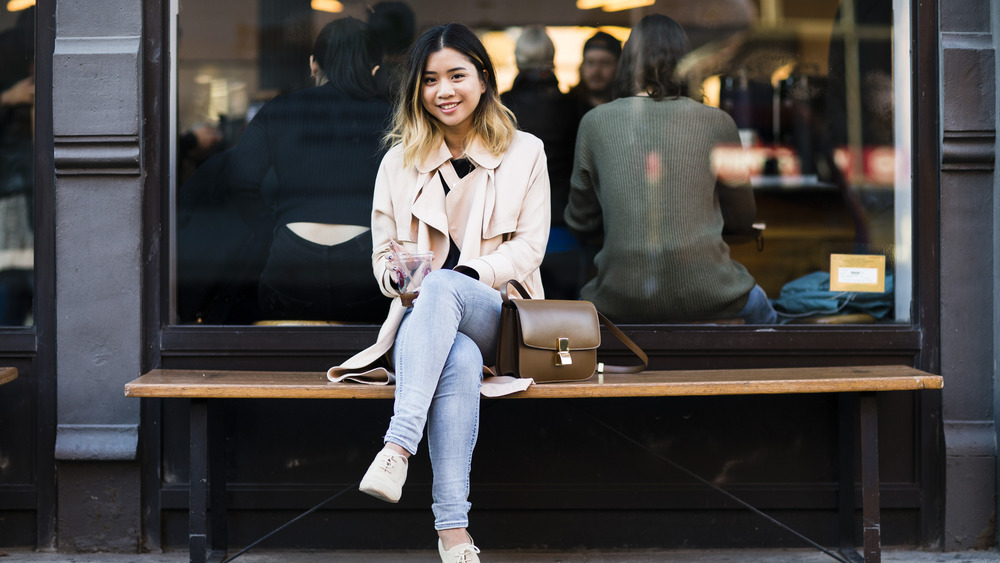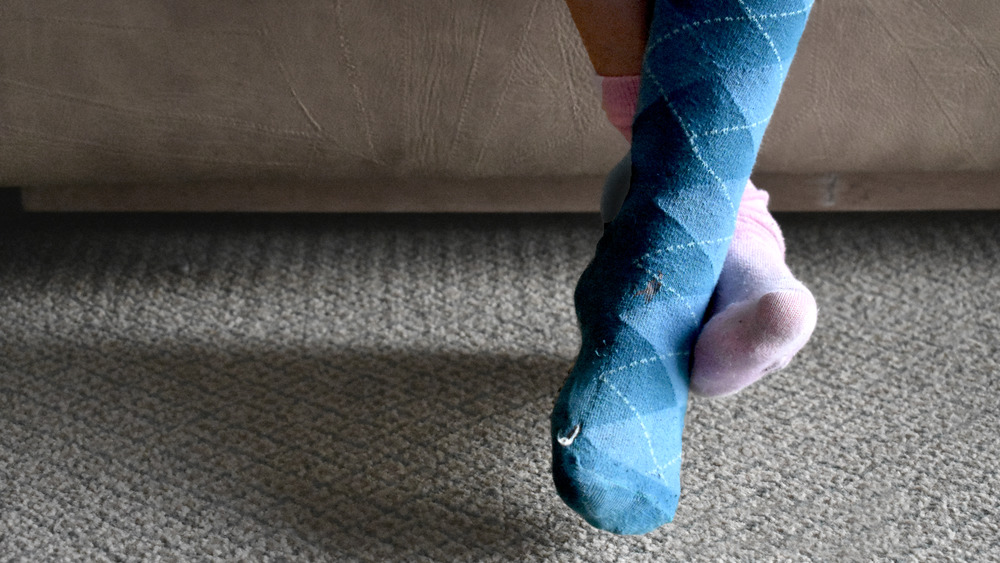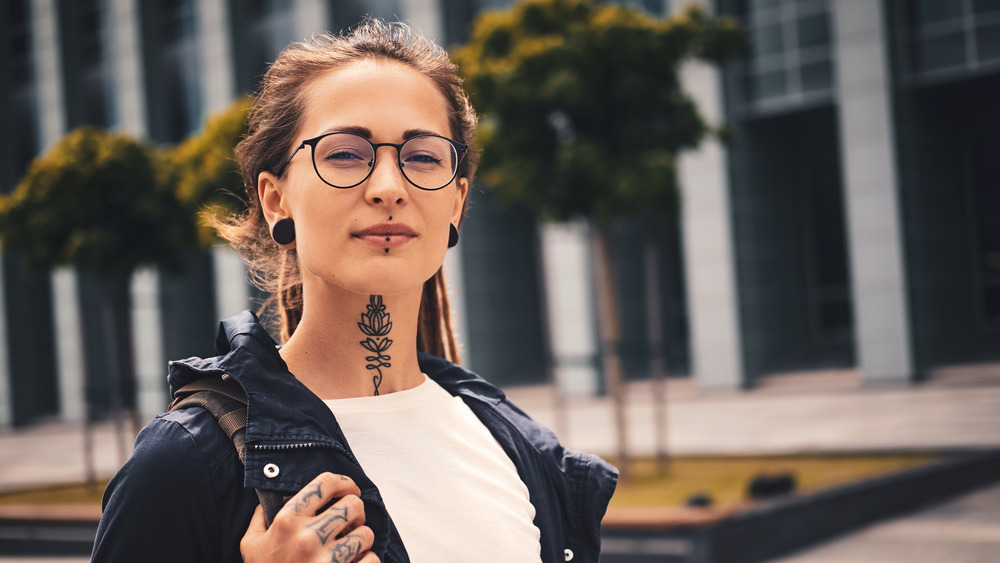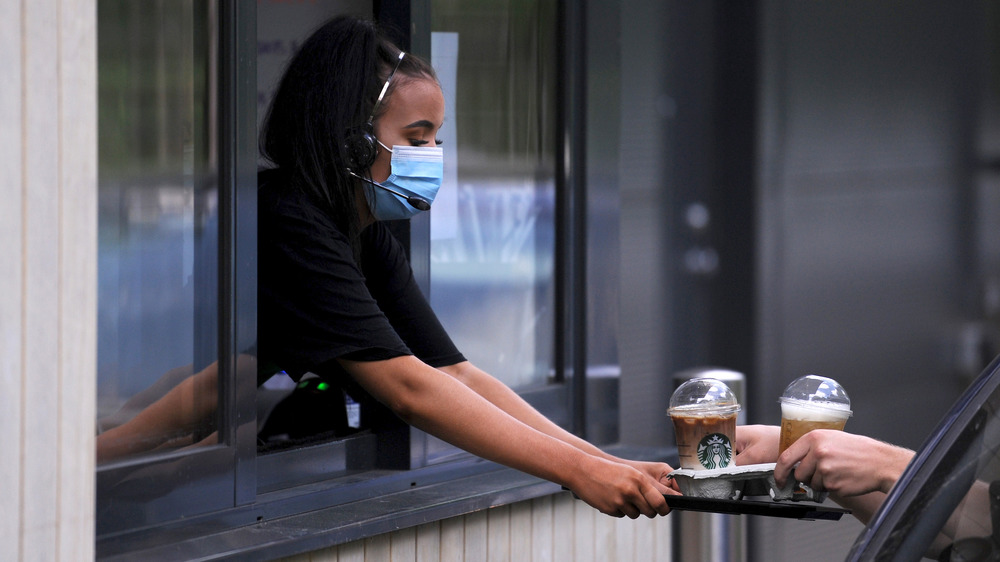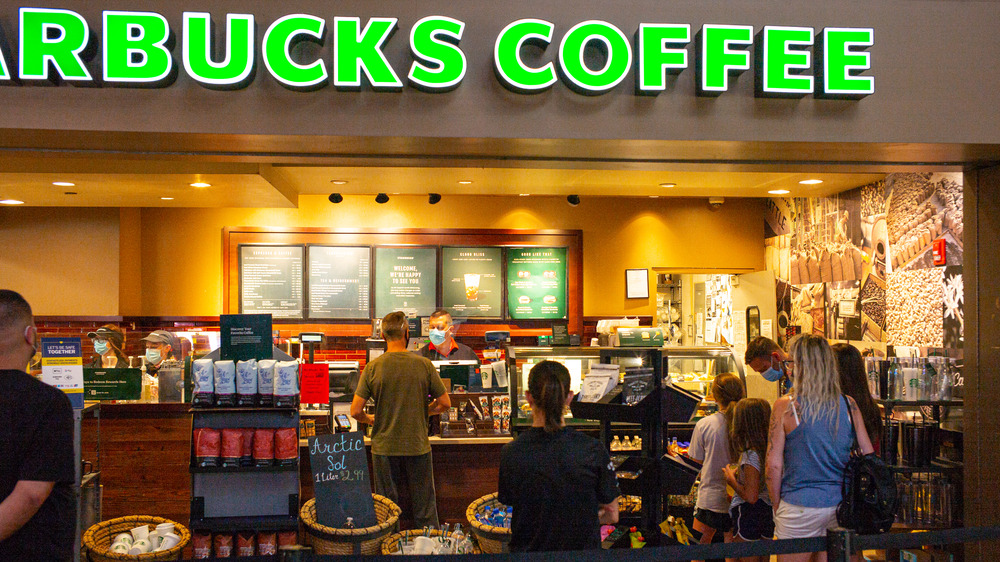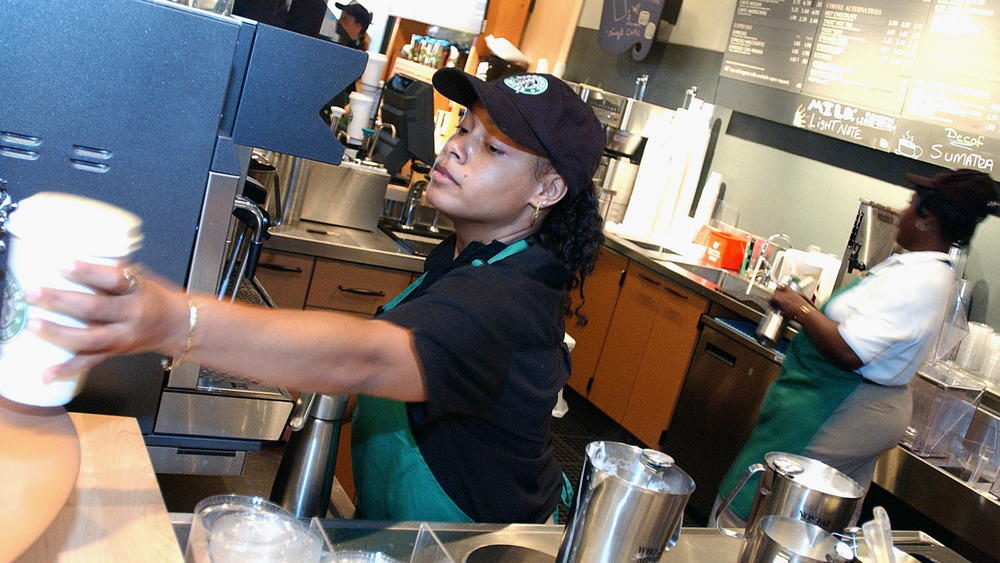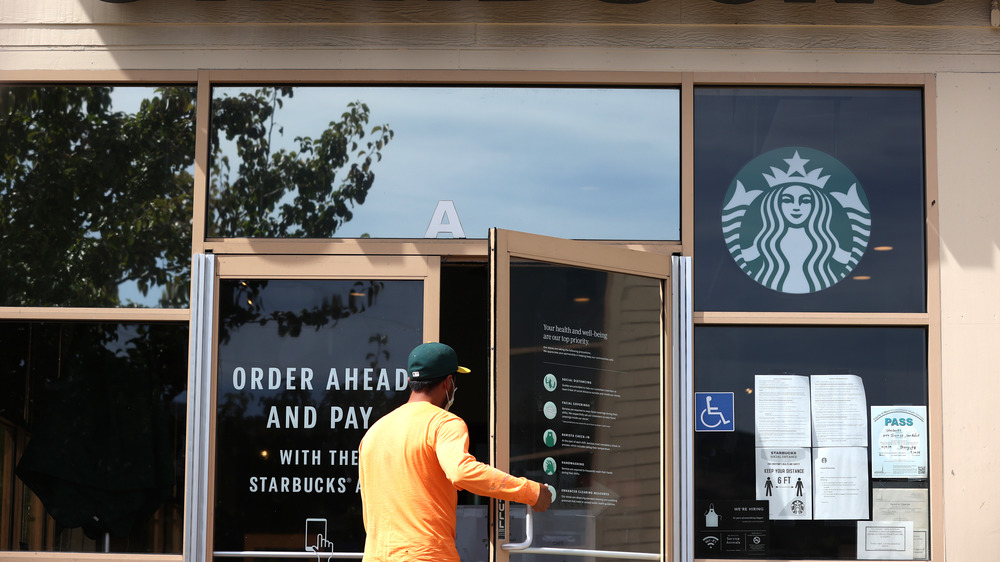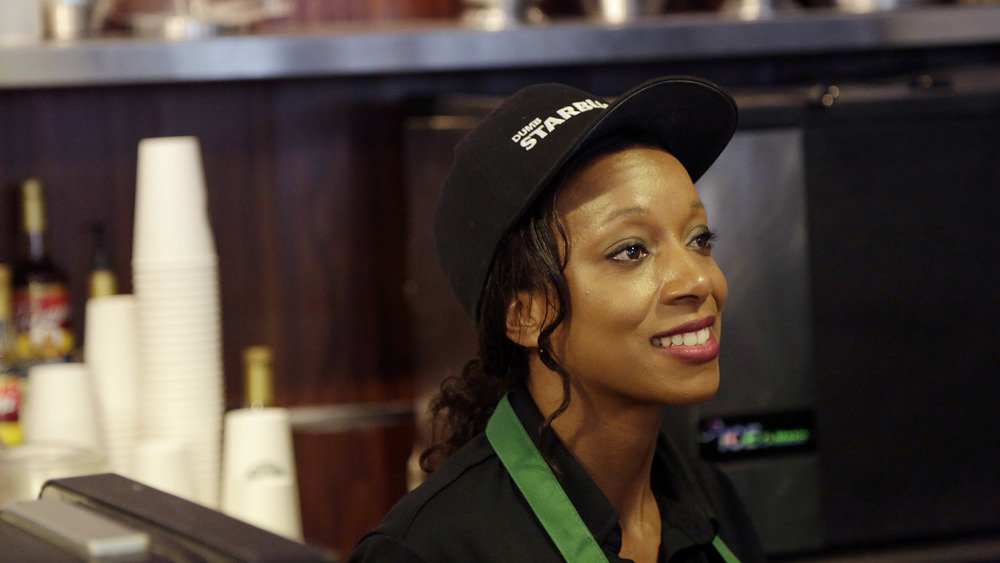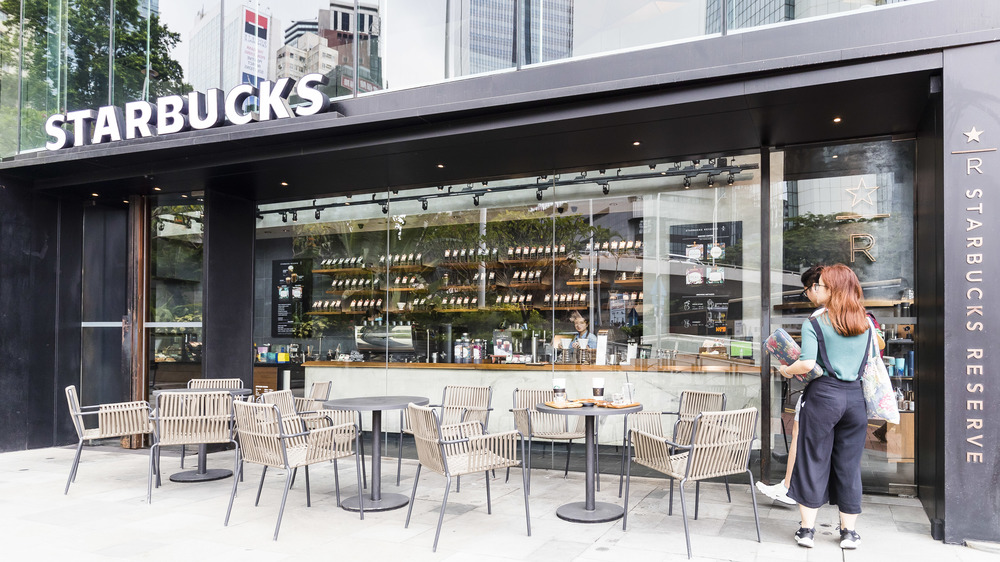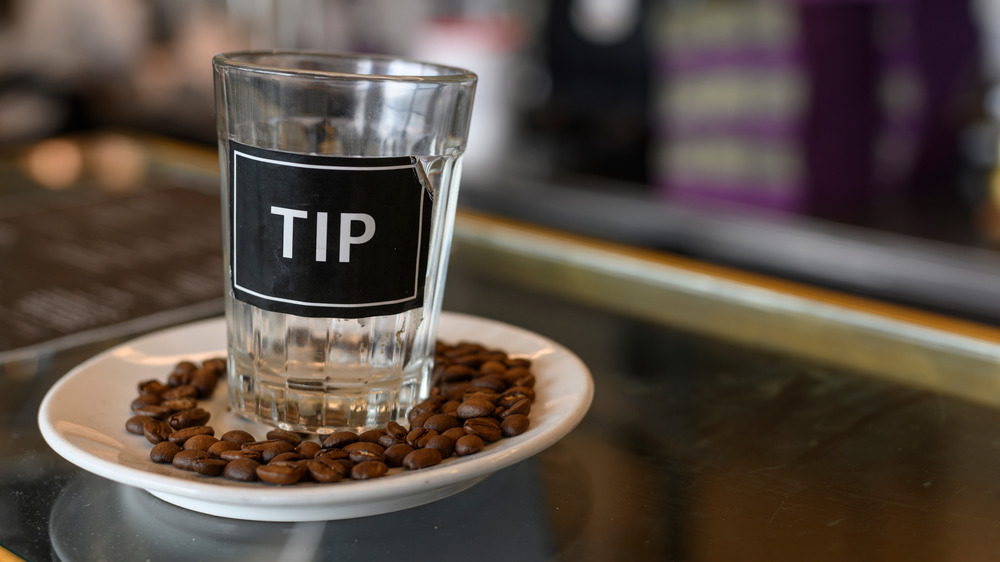Weird Rules That Starbucks Workers Have To Follow
Walk into any Starbucks in most parts of the world, and you're pretty much guaranteed to have the same experience as you would at your hometown Starbucks, more or less: A fresh-faced, green-aproned crew greets you with a smile. You follow the same process you always have for ordering your drink and customize as usual. You then stand to the side of the baristas and wait for your name to be called. If you sit down at one of the tables and stick your nose into a book, you may completely forget you're at a different Starbucks at all.
The Starbucks experience is a very carefully curated and designed one. Lots of research goes into making a Starbucks trip exactly what it is, down to how the employees must behave, dress, talk, and respond to customer requests. Some of the rules that Starbucks workers have to follow, however, are a little on the weird side and may even be unnecessary — but then again, a Starbucks exec would likely tell you that having it any other way simply wouldn't be Starbucks.
Check out some of the weird rules that Starbucks employees have to follow and see if you can spot them in action the next time you grab your favorite Starbucks treat.
Weird hair colors are okay, but Starbucks asks their employees to commit to them
Starbucks really has no problem with employees dyeing their hair any shade of the rainbow. However, if they're going to go all out with some unnatural hair color, the chain asks them to commit to it. In other words, Starbucks doesn't allow its workers to wear temporary hair dye, and other temporary hair changes – including colored hair sprays, hair glitter, and hair chalks – are also off-limits.
The Starbucks employee style guide asks that all hair color is permanent or semi-permanent for the sake of food safety. It seems like Starbucks is worried some unsuspecting customer might open the lid to their macchiato and find a bit of hair glitter floating on top. You might be wondering, though: If semi-permanent hair color is okay, then why not temporary hair color? What's the difference?
Semi-permanent hair color sits on the surface of your hair and lasts between four and 12 shampoos before fading, whereas temporary hair color washes out with one shampoo, making it much more susceptible to fall out, according to MATRIX. If you've ever used temporary hair color, you can likely attest to the way it can get just about everywhere if you're not careful, which could mean staining clothes, tissues, and anything else that your hair touches.
Starbucks kindly asks employees to leave "loud" personal styles at home
When it comes to employee regulations, including about clothing, Starbucks can seem pretty militant. Think about it — every time you've gone into a Starbucks, what were the employees wearing? Probably nothing memorable, right?
The Starbucks employee handbook and style guide goes a long way to ensure that this is the case by inviting employes to wear a variety of colors that are "subdued." According to the guide, these subdued colors include black, white, gray, navy blue, and brown. But Starbucks goes beyond simply monitoring the color of its employees' clothing. The guide specifically addresses patterns, too, once again using the words "muted" and "subdued" to describe what's acceptable, including small stripes, plaids, and "tight" patterns.
"Busy" and "bold" patterns are also a no-no, with Starbucks stressing that overall, "solids are your friend." Specific shirts that Starbucks employees aren't allowed to wear include any shirts with loud colors or "busy" embroidery, as well as those featuring large logos or an inconsistent wash. And don't even think of wearing plaid or a pattern that features colors not under the list of approved hues!
This type of jean is still not allowed at Starbucks
When it comes to jeans, the trends change almost every year. From bell bottoms to skinny jeans, dark wash to light wash, distressed to bejeweled, blue jeans come in many forms and fashions. Light wash jeans have been growing in popularity over the last few years, regardless of the cut you prefer, but Starbucks still says "no" when it comes to employees dressing in this particular pant style. Instead, it asks employees to only wear bottoms in darker denim or fabrics in black, navy, or brown.
The only light colors permitted for Starbucks employee bottoms are grays and khaki (forget the white, even in the summer). Other types of pants that Starbucks employees can't get away with include jeans with holes, baggy jeans, jeans that are too long, leather pants, athletic pants, and sweatpants.
This might be an employee rule that dates Starbucks, though. As jeans become more acceptable workplaces, light-wash jeans are becoming more appropriate in some casual work environments, reports Indeed. Perhaps Starbucks will allow its employees to join that trend someday soon.
Starbucks controls the tiniest details — right down to employees' socks
If there's one way you might think a Starbucks employee is safe to show off their personal style, it would be through socks, right? After all, socks are basically underclothes, and if a boss can't tell an employee what type of underwear to wear, can they really dictate what type of socks are allowed? Well, if you work at Starbucks, they certainly can.
If a Starbucks employee's socks are covered, they're good to go, but if others can see them, then the socks have to follow Starbucks' color and pattern guidelines. As Starbucks says regarding socks in its employee style guide, "Solid colors, simple patterns, or prints work best."
And Starbucks pays attention to several other tiny details when it comes to employees. The chain also has policies on shoe choices (canvas and mesh shoes are a no-go, as are any white shoes), hat styles, ties, and scarves. As with everything, the general color and pattern guidelines must be followed, and you can leave your bucket hats and fedoras at home, along with any long scarves or any tie that's going to clash with your requisite green apron.
Tattoos and piercings? Starbucks tells employees to cover 'em up
When it comes to tattoos and piercings, Starbucks' employee rules are just as strict as you'd probably expect them to be, considering the other items on this list. Starbucks employees cannot show off any face or throat tattoos, and any tattoo with questionable imagery must be covered as well. The chain also doesn't allow more than two earrings per ear, as well as no septum piercings. No jewelry is allowed on the hands or wrists, including watches (you can wear one plain band, so wedding rings are good to go, though engagement rings are not).
While you might think that Starbucks' employee dress code rules are a bit harsh, they were once much harsher. In 2019, Starbucks slightly adjusted its dress code to allow facial piercings for the first time, including nose studs and ear gauges, though they couldn't be larger than a dime.
According to Yahoo! a Starbucks representative noted, "We believe the Starbucks Experience is best delivered when partners can bring their whole selves to work. Based on partner feedback, we have simplified our resources and approach to dressing code to provide more clarity and make it easier for partners to select their wardrobe for work."
Cleanliness is next to godliness at Starbucks
Most working adults probably understand that they should go to their place of employment having showered and made themselves presentable, especially when it comes to food service. But Starbucks wants its employees to wash away a few other things from their bodies, including things that might be acceptable in most other work environments: nail polish and perfume.
Regarding the former, the Starbucks employee handbook notes employees can't wear anything "that could chip or slip into food or drinks." Perfumes, as well as fragrant products like lotion or body wash, are prohibited for similar reasons, because according to Starbucks, strong scents could interfere with customer experiences.
The rule against perfume makes some sense, at least. As scent is a huge part of the dining experience, you likely wouldn't want the aroma of your coffee interrupted by a whiff of someone's Axe cologne or overly floral perfume.
Starbucks employees aren't allowed to ask you to leave
If you like to go to Starbucks to work, you may feel like you need to earn your favorite chair with consistent purchases. A coffee every hour should be enough to keep your place, right? Well, turns out you don't have to buy anything to sit inside a Starbucks — not even a single coffee.
In 2018, PBS reported that Starbucks changed its policy to allow anyone to sit in their cafes for as long as they want, and employees could not ask that person to leave. The change was a result of controversy: a Philadelphia Starbucks employee had called the police to report that two Black men, who were waiting for a meeting with a real estate investor, had not made purchases at the cafe and refused to leave when asked. Video taken by a bystander revealed the men were sitting calmly, yet when Philadelphia police arrived, the two men were arrested. The video of the arrest went viral and Starbucks announced it would close many of its doors for a day of racial bias training.
As a result of the policy change, the only time Starbucks employees are permitted to report a customer who is not leaving is if they feel someone is a threat to safety. Employees are also not allowed to ask that person to leave. Instead, they're supposed to call the police.
Starbucks employees can't really work any faster than they already are
If you ever feel you've had to wait a long time for your order at Starbucks, you should know that your baristas are most likely working as fast as they're permitted to. In 2010, Starbucks made changes to their employee guidelines that may have left customers waiting longer. This rule change dictates that Starbucks employees are not allowed to make more than two drinks at one time, and they can only start making a second drink once they are almost finished with the first.
Additionally, employees have to steam milk for each Starbucks drink separately, versus steaming a larger batch of milk at once. The rules also say that employees have to wash certain tools after every drink, that they can only use one espresso machine at a time, and that they aren't allowed to move from work station to work station.
The policies were intended to create a more efficient coffee line, but as soon as they were rolled out, Starbucks employees reported that things weren't as efficient as they should've been. The Wall Street Journal quoted one employee as saying that wait times doubled in some cases, and longer lines were the result.
Need a potty break? Head to your nearest Starbucks
If you've ever been touring a city and needed to find a restroom fast, you've likely walked into a chain restaurant in hopes that they'd let you use the bathroom in exchange for a purchase. But the next time you need a potty break and there's a Starbucks nearby, feel free to walk right into the café and ask to use the restroom, no purchase required.
At the same time that Starbucks eliminated its no-loitering rule, it also changed guidelines around who could use the coffee chain's bathrooms. Now, anyone can head to Starbucks for a bathroom break without having to buy a drink. Even if you're in an area where the Starbucks bathrooms are typically locked, all you have to do is ask the employee for the key code or key, and they're not allowed to deny you.
While the new bathroom rule was intended to better serve customers, according to a University of Texas study, the policy change actually reduced Starbucks visits. Starbucks in-store visits decreased by nearly 7 percent following the decision, and this decrease was more than 80 percent higher for stores located near homeless shelters. The customers who did go into Starbucks also reduced the amount of overall time spent inside the cafe.
A Starbucks employee isn't technically allowed to tell you 'no' to most things
The Starbucks policy against telling customers "no" when they ask to use the restroom extends even further: Technically, Starbucks employees aren't supposed to tell you "no" at all, regardless of what your request might be — rather, the policy is "just say yes."
According to former Starbucks employee Carrie Dils, "The concept is simple: If a customer brings up a problem or complaint, offer them a resounding YES. Don't focus on what you can't do for a customer, tell them what you can do for them." For example, Dils says if a customer asks an employee to microwave a drink for them because it's been sitting next to a laptop for an hour, the employee may not be able to say they can microwave the drink, but they can say "yes, I'll warm it up for you, but with some steamed milk instead."
So, the next time you have a special request at Starbucks and you think there's no chance that the employee will help you out, go ahead and ask.
Here are some very strict exceptions to that "no"
There's two specific customer requests that Starbucks employees are required to give a resounding "no" to. If you ask to go into your Starbucks a little early to get that perfect seat by the window or if you ask to stay a little late to finish up that last email to your boss, you're out of luck. Starbucks employees are required to keep customers out until their exact opening time, and they must herd customers out the door as soon as the clock strikes closing time.
If you think you're an exception, you might want to think twice. In fact, one Starbucks employee told Insider that asking to break this rule is one of the most annoying things a customer can do. "There's an entire checklist of things the employees have to do before they can open the store, and they really can't open 15 or 30 minutes early for an early bird customer," the employee said.
Unfortunately, you might have to put that employee tip back into your wallet
Showing your gratitude for the service workers and other professionals in your life via tipping is a pretty nice thing to do. However, if you're thinking of offering a holiday or even a just-because tip to your favorite Starbucks barista, you might want to think twice.
Starbucks' tipping policy dictates that employees must split cash tips equally. According to a Reddit thread, how strictly this rule is enforced seems to depend on the cafe, though many employees feel peer-pressured enough to not break the rule, even when a good tip is at stake.
Starbucks employees on Reddit also reported that some customers have worked around the splitting tips rule by putting cash in a sealed envelope with an employee's name on it and asked the employee to open the envelope later, but it's unclear whether that employee is required to split what's inside. Some employees responded that they would feel bad about not splitting these kinds of tips, while others declared they understood that some of their colleagues "absolutely deserved to keep them."
Overall, it seems like the Starbucks team really is a team of people who support one another. And many employees indicate they get a pretty good share of tips, even when they're all distributed evenly.
